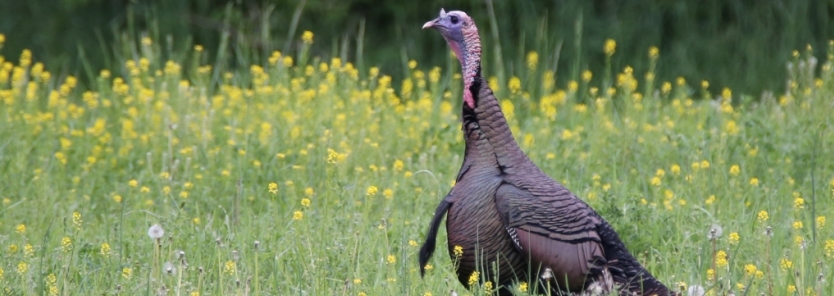While there are numerous important points that can mean the difference between a 25-pounder hanging on a limb by its spurs and an unused tag, the following three subjects are among the most vital.
1.Scout, Scout, Scout
Scouting is possibly the most important element of hunting anything, but especially turkeys. Learning roost locations, strutting zones, grit sources, bugging habitat and the lay of the land can mean everything. Now and again you may call a gobbler through a fence or blow-down, or over a creek or road, but don’t count on it happening often. You want to position yourself within an area they have utilized before that’s easy for them to access, and scouting will teach you your best options.
Learning where that bird is going to be at certain times of the day is important. Keep a journal if necessary. If you “take their temperature” while scouting, it can make it easy when it’s time to hunt.
If you scout in advance of the hunt, remember the birds may have different daily routines and possibly inhabit different areas when the season arrives. The most reliable information will be gathered within a week before you actually hunt.
2.Stay Persistent
Knowing what to do if a tom “hangs up,” stops gobbling to your calls or is traveling with live hens (as examples) is important if you wish to have consistent success. Natural turkey biology can sometimes make turkey hunting seem difficult. You can read about what to do or watch DVDs on how to handle different situations, but experience is the best teacher. Three attributes that will serve you well regardless; are persistence, patience, and hunter’s savvy.
Not every set-up is going to result in gobblers running into meet you. Persistence is important – trying again and again is how we learn. If you don’t give up, it will happen. Persistence is more important than being a good caller.
A little hunter’s savvy can go a long way. Even if you’re new to turkey hunting, but are a longtime woodsman (or woman), knowing the woods, how other animals act and how to play what Mother Nature deals you can be “a feather in your cap” (pun intended).
3.Right Tool For The Right Job
Having the correct equipment, knowing how to use it properly and how you will perform with it, is equally as important as our other points. Some of the most essential paraphernalia will be your camouflage, calls, and decoys – and let’s not forget your gun or bow.
Remember that turkeys can see color better than you or I and have eyes that are seated at the sides of their heads. Without moving their head, they can see approximately 270 degrees. That alone is amazing, but then know the fact that they have perception, or “focus” of that ENTIRE AREA, and it’s amazing! Their eyesight for picking up movement is also better than ours. Camo from head to toe is important. Colors that aren’t natural or movement will get you busted. Mossy Oak Bottomland is a great all-around pattern that blends into the shadows well.
The final tool you shouldn’t enter the turkey woods without are decoys. Decoys can accomplish a few tasks for you. They attract the bird(s) closer, draw the attention off of the hunter, and a decoy can even be used as a yardage marker if needed.









